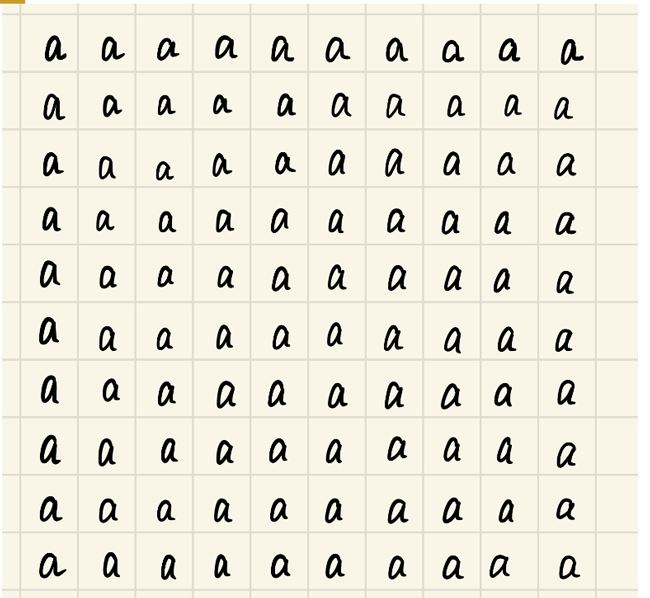Python手写拼音识别
newlw 人气:0一、算法构造
1.简单介绍一下knn算法
KNN算法,也叫K最近邻算法。功能是分类。算法逻辑非常简单,说直白点就是:先找到跟你最近的k个邻居(假设k=5),再看你的邻居给哪个类别投票(即邻居的标签),少数服从多数,得票最多的结果就是你的类别。
在这个算法中最关键的三点:
k值 :选择距离最近的k个邻居。
距离计算:计算距离的方法有欧式距离和曼哈顿距离,本文采用欧式距离,即先求差值的平方和,再开根号。
分类标签:本文的分类标签即a,b,c,d等字母
2.Python实现KNN
'''
k:k值
testdata:测试数据集
traindata:训练数据集
labels:分类标签
'''
def knn(k, testdata, traindata, labels):
'''定义算法'''
traindatasize = traindata.shape[0] #计算训练集的长度
dif = tile(testdata,(traindatasize,1)) - traindata #将测试集扩展至训练集的长度,再求差值
sqrdif = dif**2 #求差值的平方
sumsqrdif = sqrdif.sum(axis=1) #求平方和
distance = sumsqrdif**0.5 #再开根号,即所有的距离
sorted_distance = distance.argsort() #对距离进行排序,返回排序后的索引
count = {} #准备一个空字典,存放投票结果
for i in range(0,k):
vote = labels[sorted_distance[i]] #提取索引多对应的标签值作为字典的key
count[vote] = count.get(vote,0)+1 #票数作为字典的value
sorted_count = sorted(count.items(),key=lambda x:x[1],reverse=True) #对最后的投票结果进行排序
return sorted_count[0][0] #返回得票最多的标签二、准备数据
用最笨的方法,手写了一批png格式的数字图片:

图片的尺寸都是统一的:32*32像素
图片的命名也是统一的:数字标签+"_"+第n张图+“.png"
1、将图片转换成数组矩阵
训练数据集与测试数据集都是标准化后的数组矩阵,而我们的试验对象是手写体数字图片,首先需要将图片进行一下数据化处理。
def img2Model(originDataPath, modelpath):
list = os.listdir(originDataPath)
for child in list:
s_list = os.listdir(originDataPath + child)
for i in s_list:
filepath=originDataPath + child + '/' + i
# print(filepath)
img = cv2.imdecode(np.fromfile(filepath, dtype=np.uint8),0)
img = cv2.resize(img, (32, 32))
img = np.asarray(img)
img[img > 127] = 255
img[img <= 127] = 1
img[img == 255] = 0
dstFileName = modelPath + i.split('.')[0] + '.txt'
np.savetxt(dstFileName, img, fmt='%d', delimiter=' ')三、处理数据:训练集与测试集
1、区分训练集和测试集
# 随机分拣出测试集,其他文件为训练集
def shutildata(modelpath, trainpath, testpath):
txtlist = os.listdir(modelpath)
index = [random.randint(0, len(txtlist)) for i in range(10)]
# print(index)
arr = [txtlist[i].split('.')[0].split("_")[1] for i in index]
for i in txtlist:
try:
if i.split(".")[0].split("_")[1] in arr:
shutil.copy(modelpath + "/" + i, testpath)
else:
shutil.copy(modelpath + "/" + i, trainpath)
except:
pass2、加载数据
# 加载数据 def load_data(dataFilePath): arr = np.loadtxt(dataFilePath, dtype=np.int) arr = arr.flatten() return arr
3、建立训练数据
# 建立训练数据集
def makeTrainData(trainpath):
labels = []
trainfile = os.listdir(trainpath)
trainarr = np.zeros((len(trainfile), 1024))
for i in range(0, len(trainfile)):
# print(trainfile[i])
thislabel = trainfile[i].split(".")[0].split("_")[0]
if len(thislabel) != 0:
labels.append(int(thislabel))
trainarr[i, :] = load_data(trainpath + trainfile[i])
return trainarr, labels四、测试数据
# 验证
def validate(testpath, trainpath, k):
trainarr, labels = makeTrainData(trainpath)
testfiles = os.listdir(testpath)
count = 0
# 读取字典表
with open('num_char.json', 'r') as f:
dict = json.loads(f.read())
# print(dict)
for i in range(0, len(testfiles)):
testpicname = testfiles[i].split("_")[0]
testarr = load_data(testpath + testfiles[i])
result = knn(k, testarr, trainarr, labels)
testpicname = dict[str(testpicname)]
result = dict[str(result)]
print("真正字母:"+testfiles[i] +" " + testpicname + " " + "测试结果为:{}".format(result))
if str(testpicname) == str(result):
count += 1
print("-----------------------------")
print("测试集为:{}个,其中正确了{}个".format(len(testfiles),count))
print("正确率为{}".format(count / len(testfiles)))
print()加载全部内容